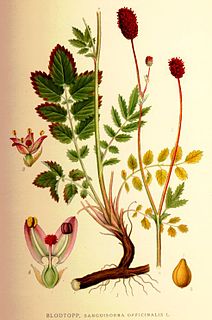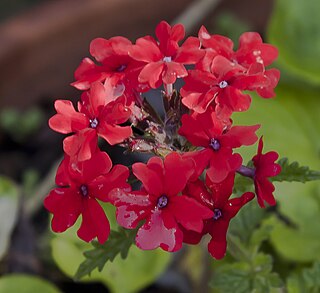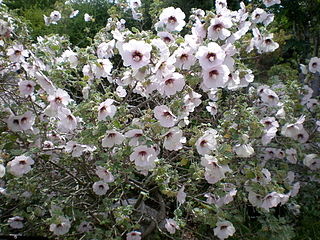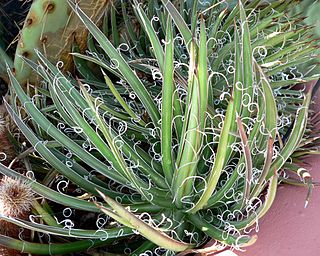
The Royal Horticultural Society (RHS), founded in 1804 as the Horticultural Society of London, is the UK's leading gardening charity.

Fargesia is a genus of flowering plants in the grass family. These bamboos are native primarily to China, with a few species in Vietnam and in the eastern Himalayas. Some species are cultivated as ornamentals, with common names including umbrella bamboo and fountain bamboo.

Sanguisorba officinalis, commonly known as great burnet, is a plant in the family Rosaceae, subfamily Rosoideae. It is native throughout the cooler regions of the Northern Hemisphere in Europe, northern Asia, and northern North America.

Symphyotrichum lateriflorum is a species of flowering plant of the aster family (Asteraceae) native to eastern and central North America. Commonly known as calico aster, starved aster, and white woodland aster, it is a perennial, herbaceous plant that may reach 120 centimeters high and 30 centimeters across. Each flower head has many tiny florets put together into what appear as one.

Passiflora antioquiensis, the red banana passionfruit, is a species in the family Passifloraceae. It is native to Colombia and is named for the Antioquia Department in Colombia where the type specimen was collected. It was originally described by Gustav Karl Wilhelm Hermann Karsten in 1859. It has gained the Royal Horticultural Society's Award of Garden Merit. With Passiflora tripartita var. mollissima it was hybridised in the Veitch Nurseries in Exeter, England in the 1870s to yield Passiflora × exoniensis, which has also gained the Award of Garden Merit.

Fargesia murielae, the umbrella bamboo, is a species of flowering plant in the family Poaceae. It is a large, clump-forming evergreen bamboo, closely resembling Fargesia nitida in the same genus, but with yellow canes.

Fargesia robusta is a species of clumping bamboo in the family Poaceae, native to Sichuan, China. Typically 3 m (10 ft) but reaching 4.5 m (15 ft), and with a narrow growth form, it has gained the Royal Horticultural Society's Award of Garden Merit as an ornamental. A number of cultivars are commercially available, including 'Campbell', 'Pingwu', 'Wenchuan', and 'Wolong'.

Verbena peruviana, the Peruvian mock vervain, is a species of flowering plant in the family Verbenaceae. It is native to Bolivia, southern Brazil, northern Argentina, Paraguay, and Uruguay, but not Peru, and has been introduced to scattered locations elsewhere, including the former Czechoslovakia, the US state of Illinois, and the Leeward Islands. Under the synonym Glandularia peruviana, its cultivar 'Balendpibi' has gained the Royal Horticultural Society's Award of Garden Merit.

Androsace laggeri, the pink rock jasmine, is a species of flowering plant in the family Primulaceae, native to the central Pyrenees. As Androsace carnea subsp. laggeri it has gained the Royal Horticultural Society's Award of Garden Merit.

Dimorphotheca jucunda, the delightful African daisy, is a species of flowering plant in the family Asteraceae. It is native to South Africa, Lesotho and Eswatini, and introduced to Ireland and Tasmania. As its synonym Osteospermum jucundum, it and two of its cultivars, 'Blackthorn Seedling' and 'Langtrees' have gained the Royal Horticultural Society's Award of Garden Merit.

Peperomia serpens, the vining peperomia, is a species of flowering plant in the family Piperaceae, native to the New World Tropics. As its synonym Peperomia scandens it has gained the Royal Horticultural Society's Award of Garden Merit as a houseplant.

Kohleria hirsuta, the woolly kohleria, is a species of flowering plant in the family Gesneriaceae, native to northern South America, and introduced to the Dominican Republic. In 1993, as its synonym Kohleria eriantha, it gained the Royal Horticultural Society's Award of Garden Merit as a hothouse plant, but the award appears to have been recently revoked.

Malva subovata, the tree mallow, is a species of flowering plant in the family Malvaceae, native to the shores of the western and central Mediterranean. As its synonym Lavatera maritima it has gained the Royal Horticultural Society's Award of Garden Merit.

Eriosyce paucicostata, the few-ribbed neoporteria, is a species of cactus in the genus Eriosyce, native to southwest Antofagasta in northern Chile. As its synonym Neoporteria paucicostata it has gained the Royal Horticultural Society's Award of Garden Merit.
Phlebodium areolatum, the Virginia blue fern, is a species of epiphytic fern in the family Polypodiaceae. It is native to the New World Tropics and Subtropics; Mexico, Florida, some of the Caribbean islands, Central America, and South America to Argentina, and has been introduced to India. As its synonym Phlebodium pseudoaureum it has gained the Royal Horticultural Society's Award of Garden Merit.

Pleioblastus fortunei is a species of bamboo in the family Poaceae. It is native to central and southern Japan, and has been introduced to southeast China, the North and South Islands of New Zealand, Maryland, Virginia, and the District of Columbia in the United States, Columbia, and southeast Brazil. It is hardy to −10 °F (−23 °C); USDA Hardiness zone 6a. It is an invasive species, escaping from cultivation and difficult to control, even surviving mowing. As its synonym Pleioblastus variegatus, dwarf white-striped bamboo, a variegated morph, has gained the Royal Horticultural Society's Award of Garden Merit.

Phedimus kamtschaticus, the orange stonecrop, is a species of flowering plant in the family Crassulaceae. It is native to China, Korea, Japan and the Russian Far East north to Chukotka, and has been introduced to the state of New York, Norway, Germany, Austria, and the Baltic States. Under its synonym Sedum kamtschaticum it has gained the Royal Horticultural Society's Award of Garden Merit. In addition, the putative variety Sedum kamtschaticum var. ellacombeanum and the 'Variegatum' cultivar have also gained the award.

Agave × leopoldii is a hybrid species of flowering plant in the family Asparagaceae. It is the result of a cross between Agave filifera and Agave schidigera, conducted in the 1870s by W.B. Kellock in Stamford Hill, London, and does not strongly resemble either parent. It has gained the Royal Horticultural Society's Award of Garden Merit as an ornamental.

Aruncus sylvester, the goat's beard, is a species of flowering plant in the family Rosaceae, found from the Himalayas to the Russian Far East and Japan. As its synonym Aruncus aethusifolius it has gained the Royal Horticultural Society's Award of Garden Merit.

















